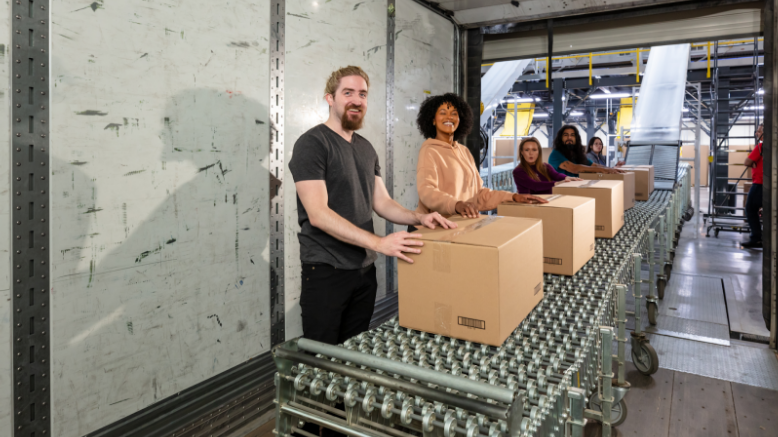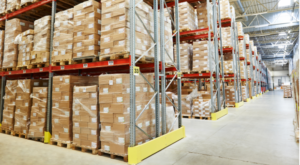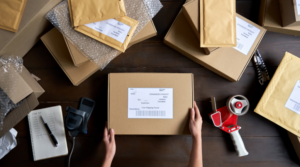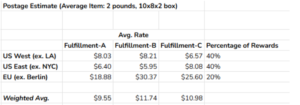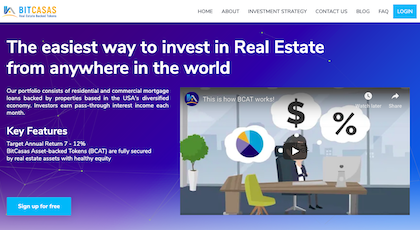Few things are quite as exciting as shipping your first Kickstarter campaign. Turning your ideas into a physical product and then sending them out to early adopters all over the world is an incredible feeling!
It’s also incredibly hard to do. Many people these days hire fulfillment centers to help with shipping, rather than boxing up everything on their own. But knowing how to choose the right fulfillment center is an overwhelming task in its own right.
One of the key reasons for that? Costs vary dramatically from fulfillment center to fulfillment center, and it’s not easy to make direct price comparisons.
That’s where we come in. In this article, we’ll help you demystify the costs associated with using a fulfillment center. We’ll explain how fulfillment centers price their services and break down the various costs.
Then we’ll show you how to estimate the total cost of order fulfillment using quotes you receive from fulfillment centers and a simple spreadsheet.
How Fulfillment Centers Price Their Services
No two fulfillment centers will have identical pricing. And even if they did, it would still take you some time to figure out what the price would be for your campaign in particular.
There’s simply no such thing as a one-size-fits-all estimate. Even online fulfillment center price calculators can only output ballpark figures.
So if you really want to understand how order fulfillment costs will look for your project, you need to request personalized quotes from each fulfillment center you’re considering. Each quote will be structured differently, so you’ll need to compare costs in a spreadsheet in order to really compare apples to apples. (We’ll cover that at the end).
As fluid as this process may seem, though, every fulfillment center will follow similar logic when providing their quotes. To that end, the basic formula to calculate order fulfillment costs is as follows:
Fulfillment Cost =
Account & Storage Fees +
((Postage + Supplies + Pick and Pack Fee) * Packages Shipped) +
Value-Added Services
We’ll break down each charge in the following sections. But first, you should know that packages shipped refers to the total number of packages that you ship during your campaign.
When it comes to orders, the more you ship, the more you pay overall. However, as you ship more, you will likely benefit from economies of scale, so your per-unit cost to ship will go down.
With that in mind, let’s talk about how fulfillment centers structure their fees.
Account & Storage
Account and storage fees are a consistent, ongoing cost linked to maintaining your inventory at a fulfillment center. Think of this as rent for your products’ storage space. These fees are typically billed monthly and can fluctuate based on the volume of your inventory, the size of the storage area needed, and the specific policies of the fulfillment center.
Account fees differ based on the fulfillment center policies. A common arrangement is to charge a certain minimum amount per month for account maintenance which may be waived if order volume is sufficiently high.
Storage costs, on the other hand, are often billed based on cubic footage or number of pallets stored. When it comes to storage, if you’re storing large, bulky items like furniture or appliances, your costs could be significantly higher than someone storing smaller, more compact items like jewelry or books.
It should also be noted that some fulfillment centers may also charge more for climate-controlled or special handling storage, so if your products require certain conditions, like a specific temperature or humidity level, you should factor these additional costs into your budget.
Be sure to seek out information on account and storage fees in any quote you receive from a fulfillment center. If you do not see account and storage fee information in your quote, be sure to ask.
Pick & Pack
Pick and pack fees cover the cost of workers retrieving each item from your inventory, packaging them securely for shipment, and printing and attaching postage labels. Each order processed incurs this fee. If you ship a lot of orders, the cumulative cost of pick and pack fees can add up quickly.
“Picking” means retrieving items from storage. “Packing” means taking one or more items and putting them into a package to be shipped. For that reason, many fulfillment centers will have a pick and pack fee structure that looks something like this:
- Pick and pack fee: $2.50
- Per additional item: +$0.15
It’s also worth noting that some fulfillment centers may offer discounts for high-volume businesses. If your campaign is going to involve shipping a huge number of orders, it’s worth negotiating a reduced pick and pack rate.
Postage
Postage costs vary widely based on the size and weight of your items, the destinations they’re being shipped to, and speed of shipping. Shipping large or heavy items, shipping to foreign countries, or simply shipping items using next-day air shipping can all lead to high postage fees.
Now here’s where things get complicated. Fulfillment centers negotiate lower priced rates with major carriers such as USPS, UPS, and FedEx. Every fulfillment center has a different arrangement.
For that reason, if you want to know what it will cost to ship item X to destination Y within Z days, you must ask your fulfillment centers of choice for rate sheets. Then you must find the appropriate values that correspond to your rewards and where you plan to ship them.
Where your fulfillment center is located is going to have a big impact on postage rates as well. If you are shipping to Europe from the US, it will cost more than shipping to Europe from within the European Union.
Supplies
Fulfillment centers generally include basic packaging supplies as part of the pick and pack fee. However, if you have specific packaging needs – such as branded boxes, bubble wrap for fragile items, or environmentally-friendly packaging materials – you will need to factor in additional costs. These costs can differ significantly depending on the type and quantity of specialized materials you require.
Be sure to ask for more information and factor in these prices if you expect to use packaging supplies outside of standard polybags, padded mailers, and/or plain boxes.
Value-Added Services
Fulfillment centers can do a lot more than just basic storage and shipping. These services can range from custom packaging, kitting (assembling multiple items into a single package), product inspections, to return processing, and more.
Pricing for these services can differ widely from center to center and often depends on your specific campaign needs. For example, if your product requires assembly before shipment – like a gift basket – you might opt for a kitting service, which would incur an extra fee.
If you want to really provide a personal touch, some centers might value-added services like gift wrapping or personalized notes for customer orders, especially useful for keeping up that old-school Kickstarter feeling of new creators making their way into the business world for the first time, building relationships one by one.
Estimating The Total Cost of Order Fulfillment
Up to this point, we’ve talked about how every fulfillment center does things differently and how it’s impossible to get a one-size-fits-all estimate. But you’re still going to want to make an informed decision and that requires being able to compare fulfillment centers to one another.
To accomplish this, start by creating a spreadsheet. Your rows will be the five basic fee types: Account & Storage, Pick & Pack, Postage, Supplies, and Value-Added Services. Your columns will be your fulfillment centers of choice. Off to the side, write down your estimated order volume.
(Note that this is a simplified model. If you’re trying to run different scenarios, you can modify this basic spreadsheet so you can compare which fulfillment center has the most favorable pricing at different order volumes like 500, 1,000, 5,000, and so on.)
First, plug in your best estimate of all the Account & Storage fees you will need to pay to ship your campaign. When in doubt, use a 3-month estimate. Then do the same for Value-Added Services. Then enter in the average pick & pack and supply costs you expect to pay on a per-order basis.
You’ll notice that we left the postage cost for last. There’s a good reason for that.
While it’s pretty easy to estimate the cost of supplies and pick and pack fees based on the quotes that order fulfillment centers provide, postage is tricky. For that, you will need a weighted average of the postage rates of places you think you will be shipping to.
The easiest way to do this is, in a separate tab, to take each postage rate estimate then estimate the percentage of items that will be shipped there or close to there. For example, if it costs $10.00 to send a 2 pound item to Los Angeles, you can use that figure as a rough estimate for shipping to the West Coast US more broadly.
Once you have a weighted average estimate for postage, you can use that figure in the original tab as a proxy for the average postage rate of a fulfillment center.
Repeat this process for each provider to compare your costs side by side. Remember, while this gives you a good estimate, actual costs may vary based on shipping destination, package weight or size, and other factors. And, of course, if your Kickstarter is not yet launched or has not ended yet, you may not even know your order volume yet!
Still, this spreadsheet approach allows you to make informed comparisons and choose the provider that best meets your needs and budget. It gives you something to play around so you can run different scenarios.
Just keep in mind – you want to pick a fulfillment center with a reasonable cost, but not necessarily the lowest cost. Shipping without unnecessary hassles is priceless!
Final Thoughts
Estimating order fulfillment costs for your Kickstarter campaign is tricky. But once you understand the logic fulfillment centers use to set prices, it’s easier to know what’s most important when you receive quotes. Then, once you make a simple spreadsheet model to compare fulfillment centers to one another, it’s a lot easier to know whose service is really worth the money.
Ensuring a smooth, efficient delivery process can set your campaign apart and put you on the road for long term business success. It’s worth investing the time and effort to get it right!
Overwhelmed with your Kickstarter? Check out our free Kickstarter checklist. It lists everything you need to know to get your Kickstarter campaign shipped.
Need help fulfilling your orders? Click here to request a quote from Fulfillrite.
Brandon Rollins is a Marketing Consultant at Fulfillrite. His main areas of expertise are online marketing and supply chain management. He also runs Pangea Marketing Agency and writes for Marketing is the Product.

